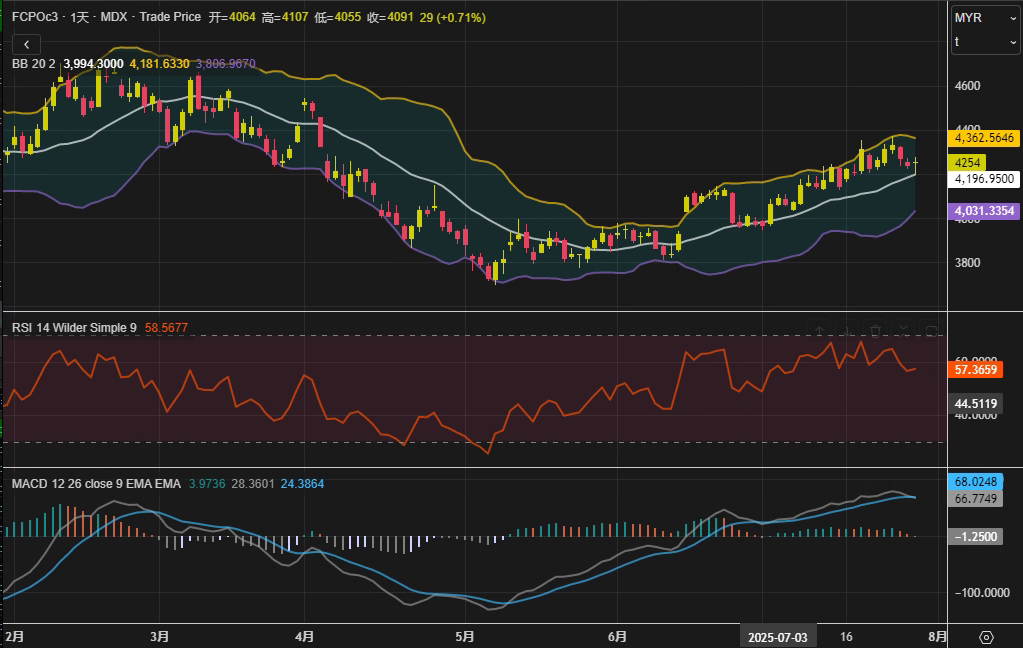Palm oil's short-term "match point" has arrived: technical indicators send a buy signal, but high inventories remain a hidden bomb
2025-07-29 18:37:12

Price support under the supply and demand game
Despite the recent continued pressure on palm oil inventories, the market's sensitivity to costs has significantly increased. On the one hand, the stabilization and rebound in international crude oil prices has enhanced the cost-effectiveness of palm oil as a biodiesel feedstock. On the other hand, the ringgit's slight depreciation of 0.07% against the US dollar has indirectly boosted overseas buyers' purchasing interest. Notably, the Dalian Commodity Exchange's main soybean oil contract (DBYcv1) rose 1.38% during the day, while the palm oil contract (DCPcv1) followed suit with a 0.61% increase. Meanwhile, soybean oil prices on the Chicago Board of Trade (CBOT) fell slightly by 0.11%, reflecting the Asian market's short-term demand for vegetable oils.
A trader in Kuala Lumpur said: "Some investors believe that the current price is close to the technical support level, and short-covering behavior has further amplified the rebound." This view is consistent with the market performance - after two consecutive days of correction, palm oil futures received buying near the lower Bollinger channel of 3,907 ringgit.
Institutional Perspective: The Balance Amidst Divergence
Analysts from prominent institutions are divided on the outlook. LMC International believes that "production growth in Indonesia and Malaysia is likely to slow in the third quarter. If exports maintain current levels, inventory pressure will gradually ease." The firm specifically emphasizes that weather disturbances in major producing countries (such as the localized drought in Sumatra) could be a potential bullish factor.
However, Goldman Sachs Commodities Research is cautious: "The global vegetable oil inventory-to-consumption ratio remains at a five-year high, and high inventories in China and India may curb import demand." Data showed that India's palm oil imports fell 12% month-on-month in June, but the country's upcoming Diwali stocking season may inject new variables into the market.
Short-term drivers and long-term concerns
From a trading perspective, the current market is more focused on immediate supply and demand changes than long-term expectations. Crude oil price fluctuations and policy adjustments in major producing countries remain key catalysts. The Malaysian government recently reiterated that it will maintain a zero export tariff on crude palm oil in September, a move that will help stabilize market share. However, if the expected bumper soybean harvest in South America in the fourth quarter materializes, the substitution effect of soybean oil for palm oil could once again suppress prices.
Technically, significant resistance exists in the 4250-4300 ringgit range, a break of which could lead to a test of the year's high. Conversely, a break below the 4150 ringgit support level could lead to a retest of the psychologically significant 4000 ringgit level. For professional traders, closely monitoring origin inventory data and macro capital flows remains a key strategic consideration amidst the interplay of multiple variables.

- Risk Warning and Disclaimer
- The market involves risk, and trading may not be suitable for all investors. This article is for reference only and does not constitute personal investment advice, nor does it take into account certain users’ specific investment objectives, financial situation, or other needs. Any investment decisions made based on this information are at your own risk.





















